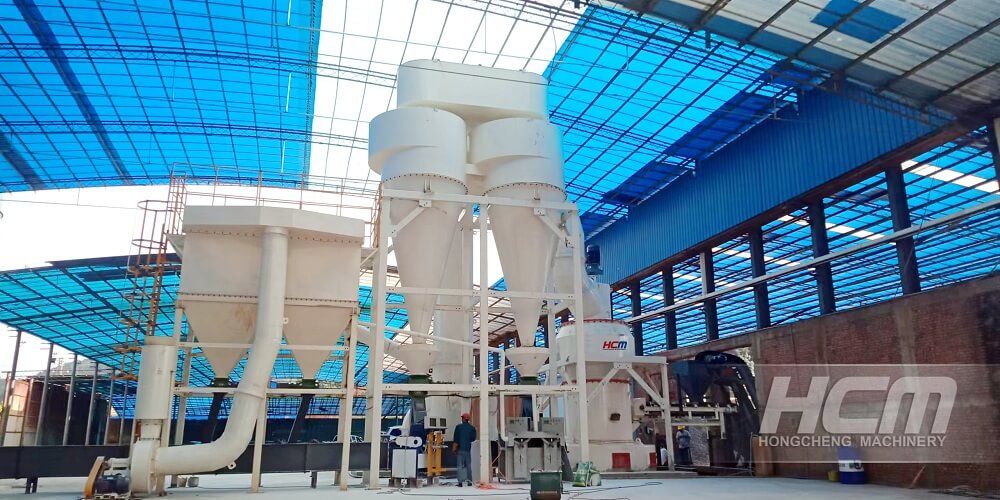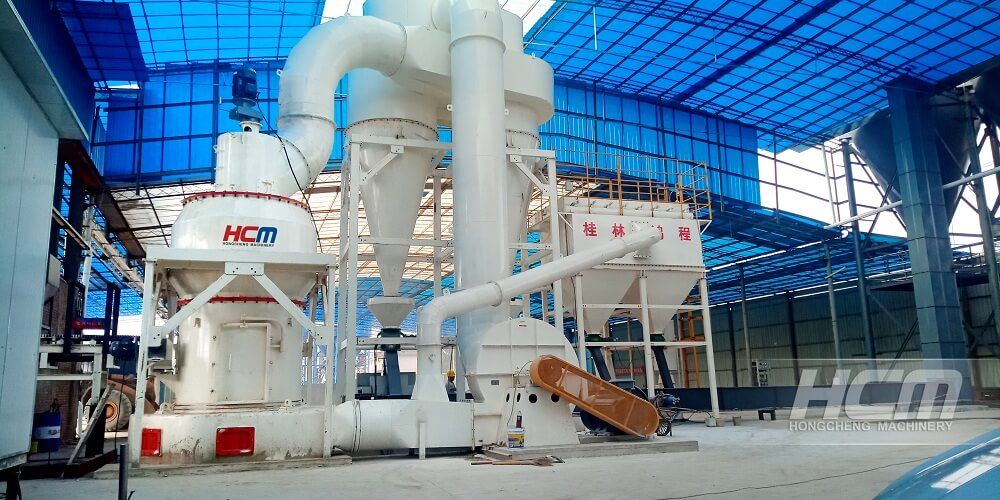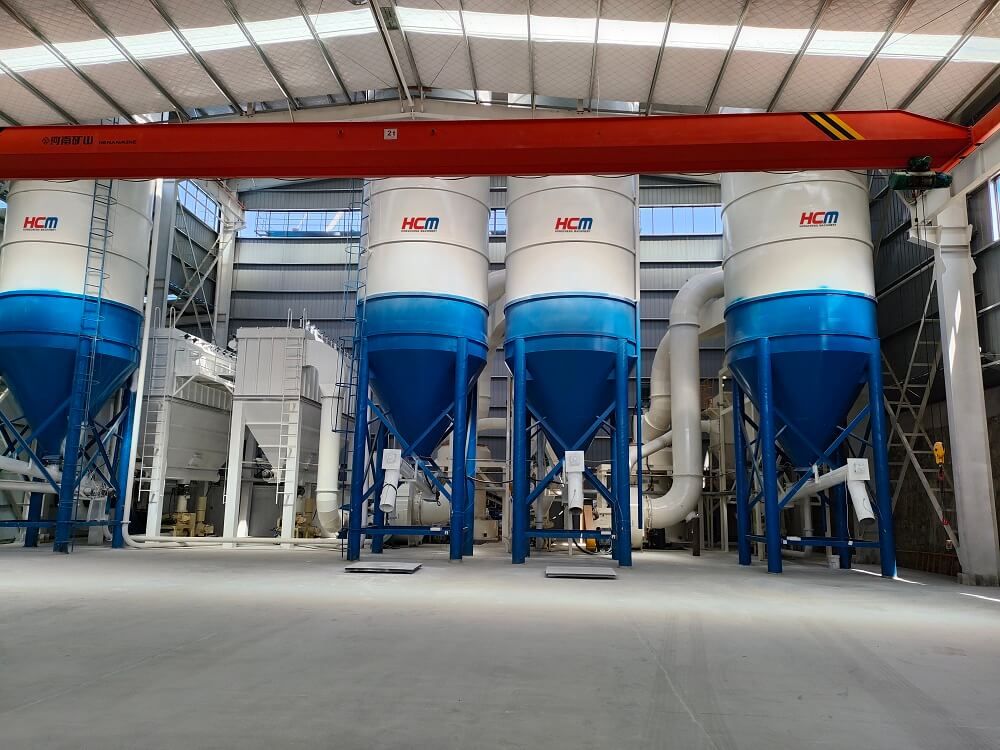In recent years, cement and slag vertical mills have been widely used. Many cement companies and steel companies have introduced slag vertical mills to grind fine powder, which has better realized the comprehensive utilization of slag. However, since the wear of the wear-resistant parts inside the vertical mill is difficult to control, severe wear can easily cause major shutdown accidents and bring unnecessary economic losses to the enterprise. Therefore, maintaining the wearable parts in the mill is the focus of maintenance.
How to properly maintain cement and slag vertical mills? After years of research and use of cement and slag vertical mills, HCM Machinery has discovered that the wear within the mill is directly related to the system’s output and product quality. The key wear-resistant parts in the mill are: the moving and stationary blades of the separator, the grinding roller and the grinding disc, and the louver ring with the air outlet. If preventive maintenance and repair of these three major parts can be carried out, it will not only improve the operation rate of the equipment and the quality of the products, but also avoid the occurrence of many major equipment failures.
Cement and slag vertical mill process flow
The motor drives the grinding plate to rotate through the reducer, and the hot blast stove provides the heat source, which enters the inlet under the grinding plate from the air inlet, and then enters the mill through the air ring (air distribution port) around the grinding plate. The material falls from the feed port to the center of the rotating grinding disc and is dried by hot air. Under the action of centrifugal force, the material moves to the edge of the grinding disc and is bitten into the bottom of the grinding roller to be crushed. The pulverized material continues to move on the edge of the grinding disc, and is carried up by the high-speed upward airflow at the air ring (6~12 m/s). The large particles are folded back to the grinding disc, and the qualified fine powder enters the collection separator along with the air flow device. The whole process is summarized into four steps: feeding-drying-grinding-powder selection.
Main easy-to-wear parts and maintenance methods in cement and slag vertical mills
1. Determination of regular repair time
After four steps of feeding, drying, grinding, and powder selection, the materials in the mill are driven by hot air to wear wherever they pass. The longer the time, the greater the air volume, and the more serious the wear. It plays an important role in production especially. The main parts are the air ring (with air outlet), grinding roller and grinding disc and separator. These main parts for drying, grinding and collection are also the parts with serious wear. The more timely the wear and tear situation is understood, the easier it is to repair, and a lot of man-hours can be saved during maintenance, which can improve the operation rate of the equipment and increase output.
Maintenance method:
Taking the HCM Machinery HLM series of cement and slag vertical mills as an example, at first, except for emergency failures during the process, monthly maintenance was the main maintenance cycle. During operation, the output is not only affected by air volume, temperature and wear, but also other factors. In order to eliminate hidden dangers in a timely manner, monthly maintenance is changed to half-monthly maintenance. In this way, no matter whether there are other faults in the process, regular maintenance will be the main focus. During the regular maintenance, hidden faults and key worn parts will be vigorously checked and repaired in time to ensure that the equipment can achieve zero-fault operation within the 15-day regular maintenance cycle.
2. Inspection and maintenance of grinding rollers and grinding discs
Cement and slag vertical mills generally consist of main rollers and auxiliary rollers. The main rollers play a grinding role and the auxiliary rollers play a distributing role. During the working process of HCM Machinery slag vertical mill, due to the possibility of intensive wear on the roller sleeve or local area? the grinding plate, it is necessary to reprocess it through online welding. When the worn groove reaches 10 mm deep, it must be reprocessed. welding. If there are cracks in the roller sleeve, the roller sleeve must be replaced in time.
Once the wear-resistant layer of the roller sleeve of the grinding roller is damaged or falls off, it will directly affect the grinding efficiency of the product and reduce the output and quality. If the falling off material is not discovered in time, it will directly cause damage to the other two main rollers. After each roller sleeve is damaged, it needs to be replaced with a new one. The working time for replacing a new roller sleeve is determined by the experience and proficiency of the staff and the preparation of the tools. It can be as fast as 12 hours and as slow as 24 hours or more. For enterprises, the economic losses are huge, including investment in new roller sleeves and losses caused by production shutdown.
Maintenance method:
With half a month as the scheduled maintenance cycle, conduct timely inspections of the roller sleeves and grinding discs. If it is found that the thickness of the wear-resistant layer has decreased by 10 mm, relevant repair units should be immediately organized and arranged for on-site welding repairs. Generally, the repair of grinding discs and roller sleeves can be carried out systematically within three working days, and the entire production line of the vertical mill can be systematically inspected and repaired. Due to the strong planning, it can effectively ensure the centralized development of related work.
In addition, during the inspection of the grinding roller and grinding disc, other attachments of the grinding roller, such as connecting bolts, sector plates, etc., should also be carefully inspected to prevent the connecting bolts from being seriously worn and not firmly connected and falling off during the operation of the equipment,thus leading to serious jamming accidents of the wear-resistant layer of the grinding roller and grinding disc.
3. Inspection and maintenance of air outlet louver ring
The air distribution louver ring (Figure 1) evenly guides the gas flowing out of the annular pipe into the grinding chamber. The angle position of the louver ring blades has an impact on the circulation of the ground raw materials in the grinding chamber.
Maintenance method:
Check the air distribution outlet louver ring near the grinding disc. The gap between the upper edge and the grinding disc should be about 15 mm. If the wear is serious, the round steel needs to be welded to reduce the gap. At the same time, check the thickness of the side panels. The inner panel is 12 mm and the outer panel is 20 mm, when the wear is 50%, it needs to be repaired by welding with wear-resistant plates; focus on checking the louver ring under the grinding roller. If the overall wear of the air distribution louver ring is found to be serious, replace it as a whole during overhaul.
Since the lower part of the air distribution outlet louver ring is the main space for replacing blades, and the blades are wear-resistant parts, they are not only heavy, but also number up to 20 pieces. Replacing them in the air room at the lower part of the air ring requires welding of slides and the assistance of hoisting equipment. Therefore, timely welding and repair of the worn parts of the air distribution port and adjustment of the blade angle during regular maintenance can effectively reduce the number of blade replacements. Depending on the overall wear resistance, it can be replaced as a whole every six months.
4. Inspection and maintenance of moving and stationary blades of the separator
HCM Machinery slag vertical mill stud-bolted basket separator is an air-flow separator. The ground and dried materials enter the separator from the bottom along with the air flow. The collected materials enter the upper collection channel through the blade gap. Unqualified materials are blocked by the blades or fall back to the lower grinding area by their own gravity for secondary grinding. The interior of the separator is mainly a rotary chamber with a large squirrel cage structure. There are stationary blades on the external partitions, which form a rotating flow with the blades on the rotating squirrel cage to collect powder. If the moving and stationary blades are not welded firmly, they will easily fall into the grinding disc under the action of wind and rotation, blocking the rolling equipment in the grinding mill, causing a major shutdown accident. Therefore, the inspection of the moving and stationary blades is the most important step in the grinding process. One of the key points of internal maintenance.
Repair method:
There are three layers of moving blades in the squirrel-cage rotary chamber inside the separator, with 200 blades on each layer. During regular maintenance, it is necessary to vibrate the moving blades one by one with a hand hammer to see if there is any movement. If so, they need to be tightened, marked and intensively welded and reinforced. If seriously worn or deformed blades are found, they need to be removed and new moving blades of the same size installed according to the drawing requirements. They need to be weighed before installation to prevent loss of balance.
To check the stator blades, it is necessary to remove the five moving blades on each layer from the inside of the squirrel cage to leave enough space to observe the connection and wear of the stator blades. Rotate the squirrel cage and check whether there is open welding or wear at the connection of the stator blades. All wear-resistant parts need to be welded firmly with J506/Ф3.2 welding rod. Adjust the angle of the static blades to a vertical distance of 110 mm and a horizontal angle of 17° to ensure the quality of powder selection.
During each maintenance, enter the powder separator to observe whether the angle of the static blades is deformed and whether the moving blades are loose. Generally, the gap between the two baffles is 13 mm. During regular inspection, do not ignore the connecting bolts of the rotor shaft and check whether they are loose. The abrasive adhering to the rotating parts should also be removed. After the inspection, the overall dynamic balance must be done.
Summarize:
The operation rate of the host equipment in the mineral powder production line directly affects the output and quality. Maintenance maintenance is the focus of enterprise equipment maintenance. For slag vertical mills, targeted and planned maintenance should not omit hidden dangers in key wear-resistant parts of the vertical mill, so as to achieve advance prediction and control, and eliminate hidden dangers in advance, which can prevent major accidents and improve the operation of the equipment. efficiency and unit-hour output, providing guarantee for efficient and low-consumption operation of the production line.For equipment quotations, please contact us by email:hcmkt@hcmilling.com
Post time: Dec-22-2023











